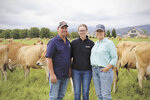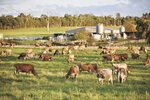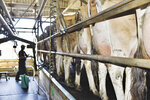


DROUIN WEST, Australia — At Kings Ville Jerseys are cows whose genetics can be traced to a cow that came to Australia aboard a ship from England.
Rob and Kerrie Anderson and their daughter, Holly, and two staff members milk 280 cows near Drouin West. The Andersons operate a grass-fed dairy that calves twice a year. Their cows are raised on 450 acres of pasture year-round.
Rob is the fourth generation of his family to milk cows, with family roots going to the 1800s in Australia.
“I enjoy milking cows,” Rob said. “You always get a great deal of satisfaction when you do something well, the cows perform well or pasture grows well and you can see the result of ... months of work or planning.”
Jerseys have been milked by Rob’s family for generations. Kerrie said continuing to breed Jersey cattle is a tie to Rob’s family.
“We have cow families that Rob’s dad bred,” Kerrie said. “We continue to breed those cows, those families as well. For us, it’s a connection to family that we don’t have with us anymore.”
The Andersons have seen success in their herd’s genetics. They have sent seven bulls to A.I. in the past five years. Currently, Kings Ville Bashful-P, with Total Livestock Genetics, is the No. 2 proven Jersey bull in Australia.
Not only do the Andersons sell bulls to stud, but they also raise bulls that are sold as herd bulls.
“We love our cows,” Kerrie said. “We know our individual cows. ... (We’re) excited for the next generation of calves that hit the ground. Our calves are nearly our most valuable asset.”
One of the Andersons’ cows with a son going to A.I. is named Treasure, a medium-sized, top-producing cow.
It is her size and production that makes Treasure sustainable, Rob said.
“If we’re all trying to get more efficient and drive production, a cow that’s got a medium body weight that’s outproducing her body weight by double is obviously a vehicle forward,” Rob said. “(Her production requires) less power to use, less cooling, less feed.”
The Andersons moved to their farm 24 years ago. The farm is about an hour and a half from the Melbourne airport and 45 minutes from the beach.
The Andersons’ farm features scenes with the soft browns of the Jerseys grazing contrasted with the lush green of the paddocks backed by a range of hills and a state forest to the north.
Though the cows are grass-fed, their milk is not organic.
“Australia has a ‘green’ image because we’re a pasture-based system,” Rob said. “They’re not housed; they’re not confined. So, you get a little bit of a kick from that point of view just from ... the way we farm.”
The Andersons said their farm would be considered medium-sized as large farms in Australia typically milk 600-1,000 cows.
The Andersons said their home state of Victoria is a dairy state. The Andersons have access to industry support and feed. They also have four dairy processors within an hour of them and six processing facilities they could send their milk to.
Rob said the dairy markets have changed. Australia used to be a more export-heavy market with volatile prices, but this has changed.
“Our milk pool has shrunk a little bit,” Rob said. “The domestic market or our local market has ... kept the floor and our price a little bit more (stable).”
Because Australia is in the southern hemisphere, winter begins in June. The Andersons experience four seasons.
Though they can see snow in the hill range, their farm receives no snow but does get frost. During winter, Rob said the minimum temperature ranges from 32 to 41 degrees. In the summer, the max temperature is around 100 degrees, but Rob said it is not consistently hot.
The Andersons said their environmental handicap is fighting the rain.
“There are some seasons where we can just not get off the hay or silage that we want to,” Kerrie said. “Last season, it just kept raining, and we did not get our silage done.”
The Andersons supplement their pasture ration as needed with forages. Their cows are also fed grain daily. They vary the grain according to energy and protein needs across seasons.
The Andersons generally move their milking herd to a new paddock or strip every 12 hours. Dry cows are moved once a day, and heifers are moved every three days.
The Andersons have about 60 paddocks that they graze in two or three strips each. The rotation between paddocks depends on the time of year. In the spring, this can be as short as 17 days, and during the winter, this rotation can stretch to 50 days.
The Andersons harvest silage and hay from the paddocks, which are about 95% ryegrass mixed with clover and other plants. The mix works well as the clover fixes nitrogen for the rye, and the rye balances the tonnage loss and richness of the clover. The Andersons do not raise corn.
The Andersons’ calving season is from February through April and again from July through September.
“It suits us better here because of our seasons,” Kerrie said. “We want (the cows) to be lifting when we go into the spring pasture peak.”
Comments
No comments on this item Please log in to comment by clicking here